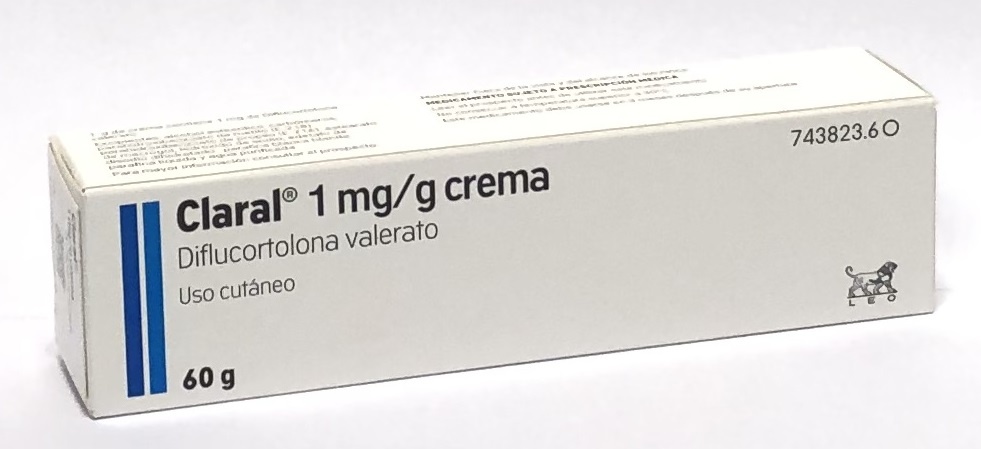

КЛАРАЛ 1 мг/г КРЕМ

Запитайте лікаря про рецепт на КЛАРАЛ 1 мг/г КРЕМ

Інструкція із застосування КЛАРАЛ 1 мг/г КРЕМ
Вступ
Опис: інформація для користувача
Кларал 1мг/г крем
Дифлукортолон валерат
Прочитайте уважно весь опис перед тим, як почнете використовувати цей лікарський засіб, оскільки він містить важливу інформацію для вас.
- Збережіть цей опис, оскільки вам може знадобитися знову його прочитати.
- Якщо у вас є якісь сумніви, проконсультуйтеся з вашим лікарем або фармацевтом.
- Цей лікарський засіб призначений тільки для вас, і його не слід давати іншим людям, навіть якщо вони мають相同ні симптоми, оскільки це може нашкодити їм.
- Якщо ви відчуваєте побічні ефекти, проконсультуйтеся з вашим лікарем або фармацевтом, навіть якщо це побічні ефекти, які не вказані в цьому описі. Див. розділ 4.
Зміст опису
- Що таке Кларал 1 мг/г крем і для чого він використовується
- Що вам потрібно знати перед тим, як почати використовувати Кларал 1 мг/г крем
- Як використовувати Кларал 1 мг/г крем
- Можливі побічні ефекти
- Збереження Кларал 1 мг/г крему
- Зміст упаковки та додаткова інформація
1. Що таке Кларал 1 мг/г крем і для чого він використовується
Містить як активну речовину дифлукортолон валерат: це лікарський засіб проти запалення (потужний кортикостероїд) для використання на шкірі.
Кларал зменшує запалення і алергічні реакції шкіри. Зменшує червоність, накопичення рідини (едем) і виділення шкіри, і полегшує незручності, такі як свербіж, відчуття печіння і біль.
Кларал призначений для лікування:
Форм агudas екземи (шкірної висипки) легкої або середньої тяжкості, пов'язаної з зовнішньою причиною, chẳng hạn як:
- алергічний контактний дерматит (алергія на речовину, яка вступила в контакт зі шкірою),
- іритативний контактний дерматит (реакція на речовини звичайного використання, chẳng hạn як мило),
- висипка у вигляді монети (екзема нумулярна),
- висипка з свербінням, яка з'являється на руках і ногах (екзема дішідротична),
- екзема невизначеного типу (екзема звичайна).
Екзема, викликана факторами пацієнта (екзема ендогенна), chẳng hạn як атопічний дерматит (не пов'язаний з місцевим фактором) або нейродерматит.
Висипка на шкірі з запаленням і лущенням (екзема себорейна).
Псоріаз.
ЛіHEN плановий (запалення, свербіж і папули або підвищення, маленькі фіолетові).
Кларал особливо показаний при екземі з виділенням (вологій) і на себорейній шкірі, оскільки крем має низький вміст жиру, і підходить також для зон тіла з волоссям.
2. Що вам потрібно знати перед тим, як почати використовувати Кларал 1 мг/г крем
Не використовуйте Кларал:
- - Якщо ви алергічні на дифлукортолон валерат або на будь-яку іншу речовину цього лікарського засобу (вказані в розділі 6).
- - Якщо ви страждаєте на туберкульозні або сифілітичні процеси, або вірусні інфекції (наприклад, герпес або вітрянка).
- - На ділянках шкіри, уражених розацеєю (червоним запаленням обличчя і носа), періоральним дерматитом (специфічним запаленням шкіри навколо рота), виразкою, акне звичайним, захворюваннями шкіри з тоншенням шкіри (атрофією).
- - На ділянках шкіри з реакціями, викликаними вакцинацією, в області лікування.
- - У разі бактеріальних або грибкових інфекцій шкіри, див. розділ "Попередження і застереження".
- - У оčí або на відкритих ранах.
- - У дітей молодших 4 місяців.
Попередження і застереження
Проконсультуйтеся з вашим лікарем або фармацевтом перед тим, як почати використовувати Кларал.
- - Якщо ваш лікар діагностує додатково бактеріальну або грибкову інфекцію, необхідне додаткове специфічне лікування, оскільки інфекція може погіршитися при застосуванні глюкокортикоїду.
- - Зв'яжіться з вашим лікарем, якщо ви відчуваєте розмитість зору або інші порушення зору.
- - Протизапальні лікарські засоби (кортикостероїди), chẳng hạn як активна речовина Кларалу, можуть викликати важливі ефекти в організмі.
- - Не слід використовувати Кларал на великих ділянках шкіри або протягом тривалого часу, особливо у дітей, оскільки це збільшує ризик абсорбції і значно підвищує можливість появи побічних ефектів системного характеру (в інших частинах тіла), включно з підвищенням внутрішньоочного тиску і глаукомою.
- - Потрібна велика обережність при застосуванні Кларалу на обличчі (див. розділ 3. Як використовувати Кларал).
- Для зменшення ризику побічних ефектів:
- - Використовуйте його у мінімально можливих дозах, особливо у дітей.
- - Використовуйте його тільки протягом строго необхідного часу для полегшення стану шкіри.
- - Кларал не повинен вступати в контакт з очима, відкритими ранами або слизистими оболонками (наприклад, ротом або генітальною областю, де абсорбція значно вища).
- - Повідоміть вашому лікареві, якщо ви мали попередні випадки глаукоми.
- - Не слід використовувати його в складках шкіри, chẳng hạn як пах або пахвіні.
- - Не слід застосовувати під матеріалами, непроникними для повітря і води, включно з бинтами, пластирами або підгузниками, мало проникними, крім випадків, коли це вказано лікарем для дуже резистентних випадків.
- Якщо ви перебуваєте на лікуванні псоріазу, ваш лікар повинен часто контролювати ваше захворювання, щоб спостерігати можливе погіршення.
- Якщо ви використовуєте Кларал для захворювань, інших ніж ті, для яких він був призначений, ви можете маскувати симптоми і ускладнити правильну діагностику і лікування.
- Якщо ви застосовуєте Кларал в генітальній або анальній області, зверніть увагу, що деякі його допоміжні речовини можуть пошкодити латексні вироби, chẳng hạn як презервативи. Тому ефективність цих латексних виробів як контрацептивів або засобів захисту від захворювань, що передаються статевим шляхом, chẳng hạn як ВІЛ, може бути знижена. Проконсультуйтеся з вашим лікарем або фармацевтом, якщо вам потрібна додаткова інформація.
Діти
У дітей від 4 місяців до 3 років лікар повинен зробити ретельну оцінку співвідношення користі і ризику перед тим, як призначити цей лікарський засіб. У дітей більше ймовірно, що глюкокортикоїд буде всмоктуватися в організм через шкіру і матиме побічні ефекти в інших частинах тіла, ніж у дорослих, chẳng hạn як затримка росту, особливо при наявності факторів, які збільшують абсорбцію (наприклад, під окулюванням, chẳng hạn як під гузником).
- У дітей, які лікувалися глюкокортикоїдами, може виникнути порушення діяльності деяких залоз, розташованих поряд з нирками, або порушення, характеризоване, серед іншого, круглою tváря, і підвищенням внутрішньоочного тиску.
Інші лікарські засоби і Кларал
Повідоміть вашому лікареві або фармацевту, якщо ви використовуєте, нещодавно використовували або можете використовувати будь-який інший лікарський засіб.
На даний момент не відомі взаємодії Кларалу з іншими лікарськими засобами.
Вагітність, лактація і фертильність
Якщо ви вагітні або перебуваєте в період лактації, вважаєте, що можете бути вагітною або плануєте завагітніти, проконсультуйтеся з вашим лікарем або фармацевтом перед тим, як використовувати цей лікарський засіб.
Глюкокортикоїди не повинні застосовуватися протягом перших трьох місяців вагітності, щоб уникнути ризику для розвитку плода.
Якщо ви вагітні, вам слід уникати застосування Кларалу на великих ділянках шкіри, протягом тривалого часу або з використанням окулювальних пов'язок або пластирів.
Не відомо, чи проходять складові частини Кларалу в грудне молоко. Не можна виключити ризик для дитини.
Якщо ви перебуваєте в період лактації:
- Не слід застосовувати Кларал на грудях
- Не слід застосовувати Кларал на великих ділянках шкіри або з використанням окулювальних пов'язок або пластирів, або протягом тривалого часу.
Не існує даних про вплив Кларалу на фертильність.
Відновлення діяльності і використання машин
Кларал не впливає на вашу здатність керувати транспортними засобами або використовувати машини.
Кларал містить стеариловий спирт, метилпараабен (Е-218) і пропілпараабен (Е-216).
Цей лікарський засіб може викликати місцеві реакції на шкірі (наприклад, контактний дерматит) через наявність стеарилового спирту.
Може викликати алергічні реакції (можливо, затримані) через наявність метилпараабену (Е-218) і пропілпараабену (Е-216).
3. Як використовувати Кларал 1 мг/г крем
Слідуйте точно інструкціям з застосування цього лікарського засобу, вказаним вашим лікарем. У разі сумнівів проконсультуйтеся з вашим лікарем або фармацевтом.
Рекомендована доза:
На початку лікування застосовується тонкий шар Кларалу двічі на добу або, за необхідності, тричі на добу. Як тільки симптоми покращаться, зазвичай достатньо однієї застосування на добу.
Загалом, тривалість лікування може становити від 1 тижня і не повинна перевищувати трьох тижнів. Лікування на обличчі повинно бути якомога коротшим, 1 тиждень як максимум.
Зовнішнє застосування.
Якщо ви вважаєте, що ефект Кларалу надто сильний або слабкий, проконсультуйтеся з вашим лікарем або фармацевтом.
Застосування у дітей
Кларал протипоказаний у дітей молодших 4 місяців.
У дітей від 4 місяців до 3 років лікар повинен зробити ретельну оцінку перед тим, як призначити цей лікарський засіб.
У дітей тривалість лікування повинна бути мінімально можливою.
Якщо ви використовуєте більше Кларалу, ніж потрібно
Не слід очікувати ризику після одноразової передозування Кларалу. Повторювані передозування можуть викликати побічні ефекти (див. розділ 4)
У разі передозування або випадкового прийому внутрішньо проконсультуйтеся з вашим лікарем або фармацевтом або зверніться до медичного центру, або зателефонуйте до служби токсикологічної інформації, телефон 91 562 04 20, вказавши лікарський засіб і кількість, прийняту.
Якщо ви забули використовувати Кларал
Не слід використовувати подвійну дозу для компенсації забутих доз. Якщо ви забули одну дозу, продовжуйте свій звичайний графік згідно з інструкціями вашого лікаря або як описано в цьому описі.
Якщо ви припиняєте лікування Кларалом
Можуть знову з'явитися первинні симптоми вашої шкірної проблеми. Будь ласка, зв'яжіться з вашим лікарем перед тим, як припинити лікування.
Якщо у вас є якісь інші питання щодо використання цього лікарського засобу, проконсультуйтеся з вашим лікарем або фармацевтом.
4. Можливі побічні ефекти
Як і всі лікарські засоби, цей лікарський засіб може викликати побічні ефекти, хоча не всі люди їх відчувають.
Часті (можуть впливати до 1 особи з 10): свербіж, печіння і червоність на місці застосування.
Частота невідома (не може бути оцінена з наявних даних): розмитість зору.
Як наслідок застосування глюкокортикоїдів, особливо на великих ділянках шкіри (10% або більше) або протягом тривалого часу (більше 4 тижнів), можуть виникнути наступні побічні ефекти: атрофія шкіри, сухість, розширення малих судин (телангіектазія), запалення волосяних фолікулів (фолікуліт), стрії, акне, надмірний рост волосся (гіпертрихоз), зміни кольору шкіри, захворювання навколо рота (періоральний дерматит), контактний алергічний дерматит на одну з складових частин лікарського засобу, м'якання шкіри (макерація) і вторинні інфекції, а також системні ефекти, пов'язані з абсорбцією глюкокортикоїду, chẳng hạn як підвищення внутрішньоочного тиску або глаукома (ушкодження зорового нерва), або захворювання, яке впливає на деякі залози, розташовані поряд з нирками, і характеризується, серед іншого, круглою tváря, і підвищенням внутрішньоочного тиску (синдром Кушинга), підвищення рівня цукру в крові і сечі (гіперглікемія і глюкозурія), гіпертонія, затримка рідини (едем) і гіперчутлива реакція.
Для зменшення ризику побічних ефектів див. розділ "Попередження і застереження".
Інші побічні ефекти у дітей
Відсутність побічних ефектів у новонароджених дітей матерів, які були лікувалися на великих ділянках шкіри або протягом тривалого часу під час вагітності або лактації, не може бути виключена (наприклад, зниження функції надниркових залоз у дитини, коли застосовувався Кларал протягом останніх тижнів вагітності).
Звіт про побічні ефекти
Якщо ви відчуваєте будь-які побічні ефекти, проконсультуйтеся з вашим лікарем, фармацевтом або медсестрою, навіть якщо це можливі побічні ефекти, які не вказані в цьому описі. Ви також можете повідомити про них безпосередньо через систему фармакологічного нагляду за лікарськими засобами для людини: https://www.notificaram.es. Надсилаючи повідомлення про побічні ефекти, ви можете допомогти забезпечити більш повну інформацію про безпеку цього лікарського засобу.
5. Збереження Кларал 1 мг/г крему
Тримайте цей лікарський засіб поза досяжністю дітей.
Не зберігайте при температурі вище 30°C.
Термін придатності після першого відкриття упаковки становить 3 місяці.
Не використовуйте цей лікарський засіб після закінчення терміну придатності, вказаного на упаковці, після "CAD". Термін придатності - останній день місяця, вказаного.
Лікарські засоби не слід викидати в каналізацію або сміття. Віднесіть упаковки і лікарські засоби, які вам не потрібні, до пункту збору(SIGRE) в аптеці. У разі сумнівів проконсультуйтеся з вашим фармацевтом, як позбутися упаковок і лікарських засобів, які вам не потрібні. Таким чином, ви допоможете захистити довкілля.
6. Зміст упаковки та додаткова інформація
Склад Кларалу
- - Активна речовина - дифлукортолон валерат.
- Кожен грам крему містить 1 мг дифлукортолону валерату (0,1%).
- Інші складові частини (допоміжні речовини) - м'яка біла парафін, рідка парафін, стеариловий спирт, макрогольстеарат, карбомери, гідроксид натрію, едетат динатрію дигідрат, метилпараабен (Е-218), пропілпараабен (Е-216) і очищена вода.
Вигляд продукту та зміст упаковки
Кларал - крем світло-жовтого кольору і опалесціюючий.
Випускається в тубах по 30 і 60 г, з гвинтовим кришкою.
Можливо, що тільки деякі розміри упаковок будуть випускатися.
Власник дозволу на розповсюдження та відповідальна особа за виробництво
Власник дозволу на розповсюдження:
LEO Pharma A/S
Industriparken 55
DK-2750 Ballerup
Данія
Відповідальна особа за виробництво:
LEO Pharma Manufacturing Italy S.r.l.
Via E. Schering, 21
20054 Segrate (Мілан) - Італія
Дата останнього перегляду цього опису: липень 2019 року.
Детальна інформація про цей лікарський засіб доступна на сайті Державної служби лікарських засобів та медичних виробів (АЕМПС) http://www.aemps.gob.es/
- Країна реєстрації
- Діючі речовини
- Потрібен рецептТак
- Виробник
- Інформація є довідковою і не є медичною порадою. Перед прийомом будь-яких препаратів обов'язково проконсультуйтеся з лікарем. Oladoctor не несе відповідальності за медичні рішення, прийняті на основі цього контенту.
- Альтернативи до КЛАРАЛ 1 мг/г КРЕМФорма випуску: КРЕМ, 1 мг/гДіючі речовини: methylprednisolone aceponateВиробник: Leo Pharma A/SПотрібен рецептФорма випуску: ЕМУЛЬСІЯ, 1 мг/гДіючі речовини: methylprednisolone aceponateВиробник: Leo Pharma A/SПотрібен рецептФорма випуску: МАЗЬ, 1 мг/гДіючі речовини: methylprednisolone aceponateВиробник: Leo Pharma A/SПотрібен рецепт
Лікарі онлайн щодо КЛАРАЛ 1 мг/г КРЕМ
Консультація щодо дозування, побічних ефектів, взаємодій, протипоказань та поновлення рецепта на КЛАРАЛ 1 мг/г КРЕМ – за рішенням лікаря та згідно з місцевими правилами.






